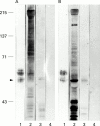Interaction of human chagasic IgG with human colon muscarinic acetylcholine receptor: molecular and functional evidence
- PMID: 11600475
- PMCID: PMC1728515
- DOI: 10.1136/gut.49.5.699
Interaction of human chagasic IgG with human colon muscarinic acetylcholine receptor: molecular and functional evidence
Abstract
Background and aims: Gastrointestinal disorders is one of the clinical manifestations of chronic Chagas' disease. The pathogenesis seems to be associated with autonomic dysfunction. Here, we consider the muscarinic cholinoceptor mediated alteration in distal colon function in chagasic megacolon.
Patients: Patients were divided into four groups: group I, chronic chagasic patients with megacolon; group II, chronic chagasic patients without megacolon; group III, non-chagasic patients with megacolon; and group IV, normal healthy volunteers (control).
Methods: Binding assay and immunoblot of cholinoceptors from human and rat colon and enzyme immunoassay (ELISA) using a synthetic 24mer peptide corresponding to the second extracellular loop of human M2 muscarinic acetylcholine receptors (mAChR) were used to detect the presence of serum antibodies. The effect of antibodies on basal tone and 3',5'-cyclic monophosphate (cAMP) production of human and rat distal colon strips were also tested.
Results: Group I but not the other groups had circulating antibodies capable of interacting with human colon activating M2 mAChR, as they competed with binding of specific radioligand to mAChR and interacted with the second extracellular loop of human M2 mAChR. Moreover, affinity purified anti-M2 peptide IgG from group I, in common with monoclonal antihuman M2 mAChR, recognised bands with a molecular weight corresponding to colon mAChR. This antibody also displayed an agonist-like activity, increasing basal tone and decreasing cAMP accumulation. Both effects were blunted by AF-DX 116 and neutralised by the synthetic peptide.
Conclusions: In chagasic patients with megacolon there are antibodies that can recognise and activate M2 mAChR. The implications of these autoantibodies in the pathogenesis of chagasic megacolon is discussed.
Figures





Similar articles
-
Functional implications of circulating muscarinic cholinergic receptor autoantibodies in chagasic patients with achalasia.Gastroenterology. 1999 Oct;117(4):798-805. doi: 10.1016/s0016-5085(99)70337-9. Gastroenterology. 1999. PMID: 10500061
-
Interaction of human chagasic IgG with the second extracellular loop of the human heart muscarinic acetylcholine receptor: functional and pathological implications.FASEB J. 1997 Jan;11(1):77-83. doi: 10.1096/fasebj.11.1.9034169. FASEB J. 1997. PMID: 9034169
-
Cardiac M(2) muscarinic cholinoceptor activation by human chagasic autoantibodies: association with bradycardia.Heart. 1999 Sep;82(3):273-8. doi: 10.1136/hrt.82.3.273. Heart. 1999. PMID: 10455074 Free PMC article.
-
Role of neurotransmitter autoantibodies in the pathogenesis of chagasic peripheral dysautonomia.Ann N Y Acad Sci. 2000;917:273-80. doi: 10.1111/j.1749-6632.2000.tb05393.x. Ann N Y Acad Sci. 2000. PMID: 11270349 Review.
-
Overview of molecular mechanisms in chagasic cardioneuromyopathy and achalasia.Medicina (B Aires). 1999;59 Suppl 2:75-83. Medicina (B Aires). 1999. PMID: 10668247 Review.
Cited by
-
Recombinant antibody against Trypanosoma cruzi from patients with chronic Chagas heart disease recognizes mammalian nervous system.EBioMedicine. 2021 Jan;63:103206. doi: 10.1016/j.ebiom.2020.103206. Epub 2021 Jan 9. EBioMedicine. 2021. PMID: 33429173 Free PMC article.
-
Chronic Chagas' heart disease: a disease on its way to becoming a worldwide health problem: epidemiology, etiopathology, treatment, pathogenesis and laboratory medicine.Heart Fail Rev. 2012 Jan;17(1):45-64. doi: 10.1007/s10741-010-9211-5. Heart Fail Rev. 2012. PMID: 21165698 Review.
-
Chagas' disease: IgG isotypes against cytoplasmic (CRA) and flagellar (FRA) recombinant repetitive antigens of Trypanosoma cruzi in chronic Chagasic patients.J Clin Lab Anal. 2007;21(5):271-6. doi: 10.1002/jcla.20186. J Clin Lab Anal. 2007. PMID: 17847109 Free PMC article.
-
Modulation of M(2) muscarinic receptor-receptor interaction by immunoglobulin G antibodies from Chagas' disease patients.Clin Exp Immunol. 2011 May;164(2):170-9. doi: 10.1111/j.1365-2249.2011.04370.x. Epub 2011 Mar 10. Clin Exp Immunol. 2011. PMID: 21391990 Free PMC article.
-
Antineuronal antibodies in idiopathic achalasia and gastro-oesophageal reflux disease.Gut. 2003 May;52(5):629-36. doi: 10.1136/gut.52.5.629. Gut. 2003. PMID: 12692044 Free PMC article.
References
Publication types
MeSH terms
Substances
LinkOut - more resources
Full Text Sources
Medical
